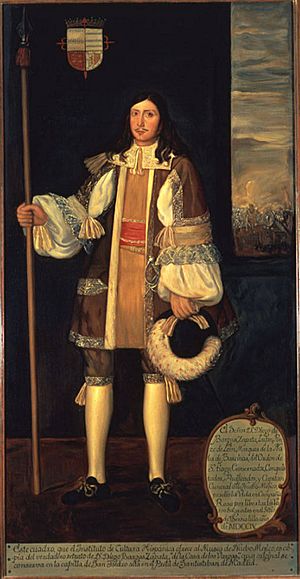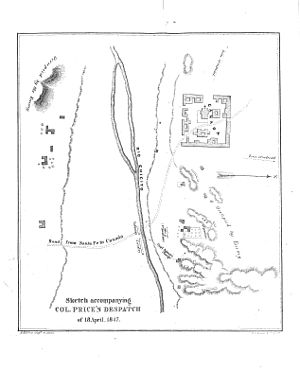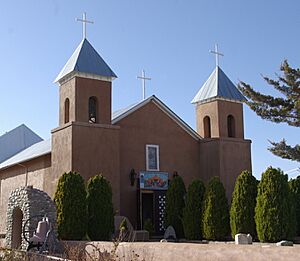Santa Cruz, New Mexico facts for kids
Quick facts for kids
Santa Cruz, New Mexico
|
|
|---|---|
| Nickname(s):
La Villa Nueva, or La Cañada
|
|
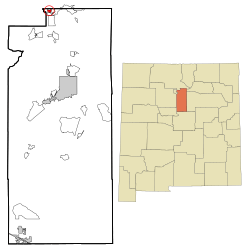
Location of Santa Cruz, New Mexico
|
|
| Country | |
| State | |
| County | Santa Fe |
| Founded | 1695-04-21 |
| Area | |
| • Total | 0.62 sq mi (1.61 km2) |
| • Land | 0.62 sq mi (1.61 km2) |
| • Water | 0.00 sq mi (0.00 km2) |
| Elevation | 5,775 ft (1,760 m) |
| Population
(2020)
|
|
| • Total | 416 |
| • Density | 669.89/sq mi (258.83/km2) |
| Time zone | UTC-7 (Mountain (MST)) |
| • Summer (DST) | UTC-6 (MDT) |
| ZIP code |
87567
|
| Area code(s) | 505 |
| FIPS code | 35-70460 |
| GNIS feature ID | 2409277 |
Santa Cruz, also known as Santa Cruz de la Cañada, is a small community in Santa Fe County, New Mexico, USA. It is a census-designated place (CDP), which means it's a special area defined by the government for collecting information. Santa Cruz is part of the larger Santa Fe area. In 2020, about 416 people lived there.
Contents
A Look at Santa Cruz's Past
Early History of the Area
The Santa Cruz area is about 25 miles northwest of Santa Fe, New Mexico. It sits in the Santa Cruz River valley. When Spanish explorers arrived in 1540, people called Tewa speakers lived here. These people were descendants of the "Ancestral Puebloans."
After the Pueblo Revolt in the late 1600s, some Tewa people from the south moved here. This happened because the Spanish wanted to resettle the area.
Spanish Settlement and Growth
Before Santa Cruz, the Spanish tried to start a colony nearby in 1598. That colony was not very successful. But it led to Spanish farms, called haciendas and ranchos, in the area.
During the Pueblo Revolt of 1680, Spanish settlers had to leave. But in 1695, after the Spanish returned, Governor Don Diego de Vargas started a new Spanish town. It was called Villa Nueva de Santa Cruz de los Españoles Mejicanos del Rey Nuestro Señor Carlos Segundo. This long name meant "The New Town of the Holy Cross of Mexican Spaniards under King Charles II." Later, it was shortened to Santa Cruz de la Cañada. "La Cañada" means "a small river or creek valley."
This new community was the second "villa" (town) the Spanish built in New Mexico. The first was Santa Fe, and the last was Albuquerque. People said the area around Santa Cruz had many fruit orchards. These orchards were watered by the Santa Cruz River.
The Tano Pueblo Natives who first lived here were moved by Diego de Vargas. By the end of the 1600s, many Tewa people left to join the Hopi people. They became the Hopi-Tewas at First Mesa.
The Santa Cruz Catholic Church is a very old building. It was built between 1733 and 1748. It replaced an older church that was falling apart. The church is still active today. It has beautiful artwork by local artists called Santeros. Visitors can still see the church on weekdays.
Changes During Mexican Rule
For many years, the people of Santa Cruz were very self-reliant. In 1821, Mexico became independent from Spain. This did not change much for Santa Cruz at first. But it did open up new trade with the United States. Before, Spain had forbidden this trade. Now, American traders came down the Santa Fe Trail. This brought new wealth to the region.
Santa Cruz de la Cañada was at the center of the Revolt of 1837. In 1835, a new governor named Albino Pérez came to Santa Fe. People did not like him. They heard he would make them pay new taxes.
In 1837, Governor Pérez put the mayor of Santa Cruz in jail. So, important people in the community started a local army. Pérez led his own forces to fight them. But the rebels defeated him near San Ildefonso Pueblo. The rebels then killed Pérez and some of his officials. They chose José González as the new governor. Later, another leader named Manuel Armijo defeated the rebels.
Under American Control
In 1846, the American Army arrived. This ended 25 years of Mexican rule in New Mexico. But in January 1847, rebels killed the first U.S. Governor, Charles Bent, in Taos. This started the Taos Revolt.
American soldiers in Santa Fe quickly moved north. They wanted to stop the rebellion. Colonel Sterling Price's troops met armed rebels in Santa Cruz. The rebels were not well-armed or trained. The American troops defeated them with cannons. This fight became known as the Battle of Cañada.
Santa Cruz Today
Santa Cruz has kept many of its old traditions. The Catholic Church is still a very important part of the community. The mission church, built in the 1700s, is still active.
In the 1880s, the railroad arrived. This led to the growth of a new town called Española. Española grew so much that it surrounded the old Spanish community of Santa Cruz. Santa Cruz was once the second most important settlement in New Mexico. Now, it is often hidden by its more famous neighbors, Taos and Santa Fe.
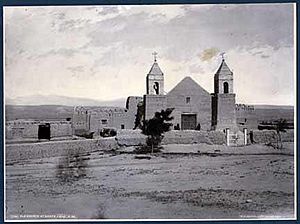
Geography of Santa Cruz
According to the United States Census Bureau, Santa Cruz covers about 0.7 square miles (1.8 square kilometers). All of this area is land.
People and Population
| Historical population | |||
|---|---|---|---|
| Census | Pop. | %± | |
| 2020 | 416 | — | |
| U.S. Decennial Census | |||
In 2000, there were 423 people living in Santa Cruz. There were 147 households and 108 families. The population density was about 608 people per square mile.
Most people in Santa Cruz were White (71.63%). About 91.73% of the people were Hispanic or Latino.
About 47.6% of households had children under 18 living with them. The average household had 2.88 people. The average family had 3.33 people.
The population was quite young. About 35.5% of people were under 18. The average age was 25 years old.
The median income for a household was $28,750. This means half of the households earned more, and half earned less. About 22.9% of the population lived below the poverty line. This included 35.0% of those under 18.
Education in Santa Cruz
Santa Cruz is part of the Española Public Schools district. The main public high school for students here is Española Valley High School.
In 1962, there was a school in Santa Cruz. The science room had been damaged by an explosion. So, people worked to build a new science room for the students.
|
See also
 In Spanish: Santa Cruz (Nuevo México) para niños
In Spanish: Santa Cruz (Nuevo México) para niños


